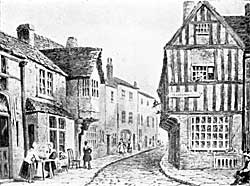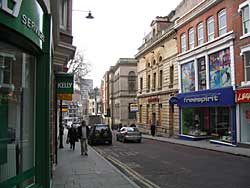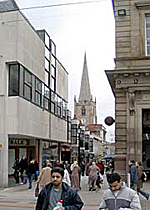< Previous | Contents | Next >
An itinerary of Nottingham
St Peter's Gate and Exchange Walk
ST. PETER'S GATE.

St Peter's Gate in the 19th century.
ST. PETER'S GATE is of very respectable antiquity being mentioned as Peter Gate in 1285. Like all other Nottingham streets it was narrow and congested during the Middle Ages and it was not until 1870 that is was widened. In the course of this widening the County Court which was erected in 1868 was constructed and a very great many beautiful half-timbered houses were swept away. One of these houses was so beautiful that Mrs. Gilbert tells us that Ruskin made a special journey to Nottingham and stopped at the "George Inn" for the purpose of making a sketch of it.
But this widening was unsufficient and the road was again widened in 1884. To effect this a slice had to be taken off St. Peter's Churchyard and one realises how old the churchyard is and for how long a period it has been used for interments when one hears that in taking off this slice it was necessary to remove no less than 2,000 bodies and re-inter them elsewhere. St. Peter's Church Walk probably refers to a footpath running across the eastern end of the churchyard and corresponds with St. Nicholas' Church Walk and with Kaye's Walk. It cannot be very ancient for as we have seen the churchyard was not fenced in the year 1641. At any rate the present fence was not set up until 1804. Peck Lane was in medieval times of great importance and carried a great deal of traffic. It is mentioned without any name as early as 1326 and appears to have been the western boundary of the property where the great family of Plumptre settled in the 13th century. It was first called Plumptre Lane in 1414 and we know that John Plumptre held land here in 1435. In 1504 it is called Peck Lane and a stream is mentioned as running down it which I suppose would go to swell the mud in St. Peter's Square. The name of Peck Lane has always been an antiquarian puzzle, the orthodox theory is that it is a corruption of "pack" and denotes a burden carried by a pack-horse, but if I may venture to advance another theory it is this. I would suggest that there were two inns, one called "The Punch Bowl" and the other "The Peacock" situated within it. They were both of considerable notoriety so much so that they were mentioned in the "Eccentric Excursion" as famous for their ale and I have wondered whether "Peck" is not really a shortening of "Peacock" and that the appropriate name of the thoroughfare should be "Peacock Lane," I confess that nowhere is it referred to as Peacock Lane, but perhaps the suggestion may bear further investigation. The maid at this "Peacock Inn" had a thrilling adventure in 1776. It appears that she was a native of Leeds and upon one occasion had attempted to visit her relatives in her old home. It was winter and it was bitterly cold and the result of her expedition was that she very nearly froze to death and was rescued from deep snow-drifts near Mansfield with the utmost difficulty.

St Peter's Gate (A Nicholson, 2004).
Great things often have small beginnings, and as a further instance of this it is pleasant to remember that the great family of Stanhope whose fame is so resounding take their origin from a draper's shop which was established in Peck Lane, but more important than this is the story of Thomas Smith. In 1658 Thomas Smith who was a son-in-law of Lawrance Collins, founder of the Collins Charity, established himself as a mercer in a shop at the corner of Peck Lane and what is now South Parade where at present stands a millinery establishment. Underneath his premises he had certain rock cellars and in these cellars he undertook to take charge of people's money and valuables. This fulfilled a long-felt want, for the custody of valuables in the Middle Ages was a constant source of anxiety to our forefathers. In London, it had been the custom for the goldsmiths to deposit their specie in the Tower for safe custody, but Charles I's action in appropriating this accumulated wealth and applying it to his own purposes had completely shaken the confidence of the nation in any such method of guarding their treasures and folk were reduced to devising hiding places wherein to secrete their wealth so that Thomas Smith's suggestion was distinctly apropos. It was found to work very well indeed and such was his fame and his honesty that folk came from far and near to avail themselves of his offer. From this small beginning he gradually extended his operations and laid the foundations of the great banking business which has come down to our own days and which is still carried on within a very few yards of the site upon which its founder started operations 270 years ago.
EXCHANGE WALK.

Exchange Walk (A Nicholson, 2004).
Exchange Walk was made in 1868. It was originally a yard which went by the name of Gears' Yard, after a certain William Gears who occupied it and who was a fishmonger in Nottingham Market Place. Then its name was changed to Farmer's Yard after James Farmer who established the drapery business upon its western side. James Farmer and the authorities of Smith's Bank saw the great benefit that would accrue to the town and to themselves by forming a thoroughfare from St. Peter's Square to the Market Place, so at their joint expense they made Exchange Walk, which was private property. The town was given a chance to secure this thoroughfare upon easy terms but refused. And so the tremendous advantage which would have accrued from a main thoroughfare suitable for vehicles passing along this roadway was lost. However, to-day it is in the hands of the town and it carries a large amount of traffic, thus relieving Wheeler Gate and saving hours of valuable time in the course of a year.
